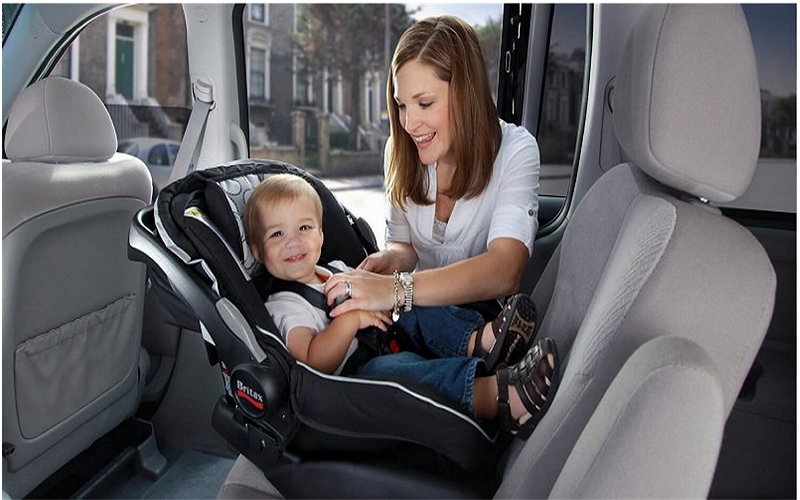When to take baby out of infant car seat? Generally, you can leave your newborn in the car seat while she is being transported. However, there are times when it’s best not to keep her strapped in for too long.
If you have a preemie or low-birthweight baby who was born prematurely and needs medical care right after birth, do not put him into his infant carrier until he has stabilized medically.

The same goes if any other complication arises that requires hospitalization during transport—it may be wise to wait until your child receives treatment before putting him back into his car seat again.
This should stop once they reach 40 pounds (18 kilograms). Some safety experts recommend keeping children between 20–40 pounds in a five-point harness booster seat until they reach the highest height and weight limits of that particular model.
Infant seats: Keep babies rear-facing for as long as possible, which is usually recommended up to at least age two or when your child reaches maximum height/weight requirements.
While many children are ready to turn forward from an infant carrier by their first birthday (the minimum requirement), true experts recommend keeping them in it longer—up to around 18 months old if not more!
This way, you can ensure that they’re staying safe while also having fun on car rides or anytime you go out together. After all, your baby likely loves being able to see everything going on around him too!
When can my child stop using a booster?
If a child is over the height and weight requirements for their forward-facing car seat, it usually means that he or she can also pass all of the other safety checks. This includes using a booster if your child needs one to ensure his/her safety in the vehicle.
The American Academy of Pediatrics recommends keeping children rear-facing as long as possible. “Age plus size” will determine when you need to switch from harnessed car seats to boosters with lap belts only.
Once they are old enough and big enough for this transition, parents should consider transitioning them into high back boosters because these types provide better head and neck protection than no backs at all.
What size car seat should my child be in?
The best way to find the right size car seat is by checking your child’s weight and height. You can check what per cent of their age they are on a chart in most stores, but it may be an easier method to look up online if you don’t have one available near you.
There are several types of car seats that parents will use for babies with different features such as compatibility or safety standards. The two major kinds include baby carriers and convertible seats which protect many stages depending upon how old your child is when using them.
Infant Car Seats: These do not convert into booster seats, so they only serve infants up until around 12 months according to most paediatricians’ recommendations. They come with a base that stays in the car, and you can attach it to your seat with the snap of a latch.
Convertible Car Seats: These types will convert from rear-facing for infants into front-facing when they are toddler age. They will last until around 30 pounds or more depending on which brand you purchase.
You also have to make sure it meets safety standards such as US standard FMVSS 213 before purchasing them, so check online if necessary at safekids.org .
Some brands may be listed there too according to their features or concerns brought up by parents who used them already. There is even one type called an all-in-one convertible car seat that starts as an infant carrier but then converts into a convertible car seat with the click of a few buttons.
Are our convertible car seats safer than infant car seats?
Convertible car seats are better than infant car seats because they have more features. Convertible car seats can be used for children up to 40 lbs, which is about three years old. Infant car seat carriers typically only take infants who weigh less than 22lbs and the average toddler weighs 30-35lbs by age two or so according to most paediatricians.
This means that your child will outgrow an infant carrier before his second birthday if he’s not a preemie! For example, my son weighed 18 lbs when he was born but just turned four last month and now weighs 33 pounds; the weight limit of the convertible baby carrier we chose allows even him (who has very long legs) plenty of room in it for the rest of this year and all of next.
What is the difference between rear-facing and convertible car seats?
A convertible car seat is a type of child restraint system, which converts from the typical “upright” position to a reclined one for infants. – There are important differences between rear-facing and front-facing car seats.
Rear-facing car seats offer more protection because it distributes crash forces across your baby’s body in a way that minimizes injury during an accident.
The face has been designed specifically to be strong enough to withstand even high speed crashes without shattering into pieces or causing internal injuries such as brain damage.
They also have much higher weight limits than forward-facing ones do, so they can serve children up until age four when they reach 40 pounds (18 kg). In contrast, most forward-facing models go no higher than 65 pounds (30 kg), which is usually around the age of two.
